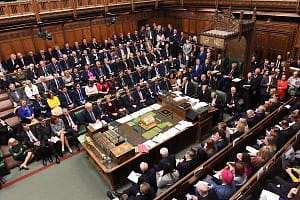Let’s focus on the Bank of Japan (BoJ), whose imminent monetary policy meeting on July 27th to 28th has the potential to be significant, not just in Japan but globally.
Any tightening in policy by the BoJ would strengthen the yen (perhaps temporarily) and be interpreted as another positive signal about the economic outlook in Japan. This would help equities there, but also would add to fears in global markets about a further tightening of global liquidity.
The key is that the BoJ is moving to a two plus two policy focus: two per cent inflation and two per cent inflation expectations.
This represents a significant break from a monetary policy which for some time was focused on a zero rates policy after decades of stagnant prices and fighting off deflation.
Currently, the BoJ has a minus 0.1% policy rate. That looks set to remain. Focus is on its yield curve control (YCC) policy where it has a target for ten-year bond yields as well as policy rates. When it tweaked this in December it caught financial markets by surprise and this had a major impact globally as well as in Japan.
The BoJ’s short-term policy interest rate has remained at minus 0.1% since January 2016. That year the BoJ also initiated YCC in September 2016 as part of its policy tool kit, setting a target for ten-year government bond yields, alongside their policy rate. When introduced, a target of zero was set for ten-year yields. In July 2018, a band of plus or minus 0.1% was set alongside the zero per cent yield target. The band widened further to plus or minus 0.25% in March 2021 and then further still to plus or minus 0.5% last December. If it were to change its YCC policy now, the scale of change would be heavily determined by its view on future inflation, as well as on its desire for stability.
If the BoJ decided it wanted to change both the level and the fluctuation band, that would be a big deal, and so it might choose to execute this in stages. For instance, if its goal was a 1% level for ten year bond yields with a 0.5% band or with a 1.0% band it might not move there in one go. Indeed, it could vary the level and the bands at different times. It would not be a surprise if they raised the target now but stuck with the same fluctuation band. Effectively this would raise the level of bond yields that they are prepared to tolerate and be seen as a tightening in monetary policy.
A shift in the BoJ’s policy stance would signal they are – finally – confident that in future inflation will hit their 2% inflation target, as opposed to undershooting it.
But if the BoJ chose not to change policy in July that, too, would be significant. For it would signal that they – and the new Governor, Kazuo Ueda, who took over in the spring – are not convinced inflation will be high enough to reach their 2% inflation target in the future.
It is only once they are confident of its achievement that the BoJ will tighten policy. They not only want to achieve a two per cent target, they want to embed it in peoples’ and firms’ expectations. Hence the two plus two focus. In my view, a change in policy should be imminent. The question is whether it occurs at this meeting, or at a subsequent one before the end of this year. The subsequent BoJ meeting is on September 21st and 22nd. Markets need to be prepared.
Different from the pack
In the aftermath of the bursting of its economic bubble, the BoJ was at the forefront of unconventional monetary policy, moving to zero rates in 1999 when deflation was the fear, and initiating quantitative easing in 2001 at a time of worries over financial stability.
In 2013 there was quantitative and qualitative monetary easing (QQE), using the BoJ’s balance sheet to buy ETFs and lower the risk premium in the stock market as well as buying government bonds to suppress yields. This was followed, as noted above, by YCC in 2016.
Its approach was referred to as Zero Interest Rate Policy (ZIRP), and was consistent with low, embedded price expectations. People didn’t expect prices to rise. Wages remained flat. Exiting from the current policy trajectory requires the BoJ to be confident about future inflation.
Core CPI, excluding food but including fuel, rose 3.2% year on year in May versus 3.4% in April. The next inflation report is expected on Friday, ahead of its policy meeting. Although inflation has been above the 2% target for over a year, the BoJ’s last forecast showed it expected inflation to dip in the year ahead, to below 2%. That forecast was in April, when the BoJ released its economic view in “The outlook for economic activity and prices”. A new forecast will be released to coincide with this policy meeting.
In April the BoJ forecast that CPI (excluding fresh food) would, after being 3% in fiscal year (FY) 22, reach 1.8% in FY23, 2.0% in FY24 and 1.6% in FY25. The focus will be on its new July forecast for this measure in coming years. If it sees it remaining at 2% then it would be more likely to tweak policy now.
Meanwhile, for CPI excluding energy as well as food, the BoJ forecast 2.2% in FY22, 2.5% in FY23, 1.7% in FY24 and 1.8% in FY25. This measure, sometimes referred to as core-core, as it strips out energy as well as food, rose from 4.1% in April to 4.3% in May, its highest rate since June 1981.
The BoJ makes clear that its policy is based on two perspectives: its examination of the baseline scenario of its economic outlook and of the most relevant risks. Its focus on stability is critical. Hence its policy actions will be gradual and while, as we saw in December, they may not necessarily be telegraphed in advance, they are likely to be clear once they are enacted, in terms of making sense and being understood.
Conclusion
Any shift from the BoJ will be gradual but nonetheless important, as they have persisted with a cheap money policy for decades and even over the last year when others have tightened, the BoJ has remained accommodative. The BoJ is shifting its focus to two plus two: achieving two per cent inflation and two per cent inflation expectations. This imminent policy meeting will be crucial in conveying whether the BoJ believes they are on track to achieve this now. If they are confident about future inflation of 2% then the BoJ could tweak their YCC policy.





Leave a Comment